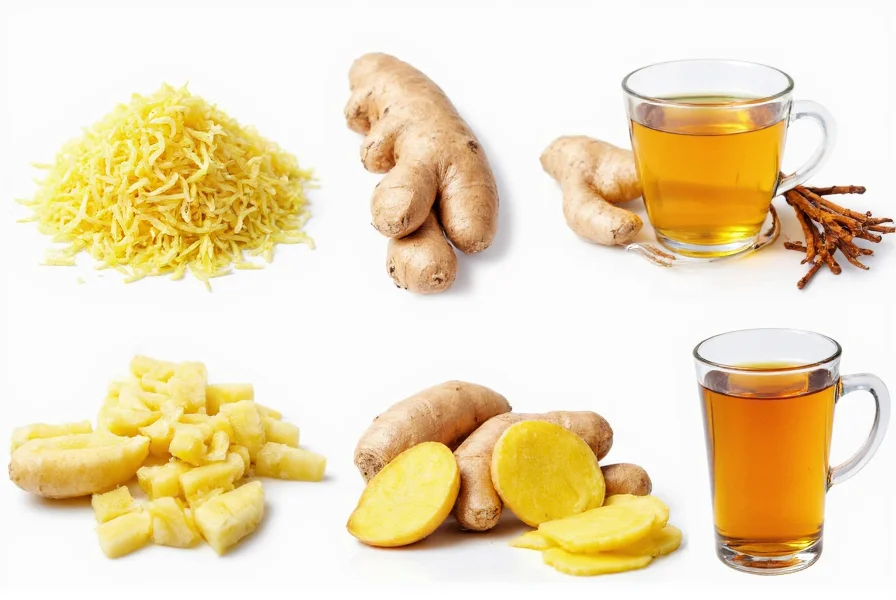Ginger root has been valued across cultures for both culinary and medicinal purposes for thousands of years. Modern nutritional science confirms what traditional medicine recognized long ago: this unassuming rhizome packs a powerful nutritional punch despite its modest size. Understanding ginger root nutritional facts helps consumers make informed decisions about incorporating this functional food into their daily diets.
Nutritional Profile of Fresh Ginger Root
Per 100 grams of raw ginger root, the nutritional composition provides essential vitamins, minerals, and bioactive compounds that contribute to overall health. Unlike many dietary supplements, ginger delivers these benefits through whole food nutrition that the body recognizes and utilizes efficiently.
| Nutrient | Amount per 100g | % Daily Value* |
|---|---|---|
| Calories | 80 | 4% |
| Carbohydrates | 17.77g | 6% |
| Dietary Fiber | 2g | 7% |
| Protein | 1.82g | 4% |
| Total Fat | 0.75g | 1% |
| Vitamin C | 5mg | 8% |
| Magnesium | 43mg | 10% |
| Potassium | 415mg | 9% |
| Gingerol | Variable | N/A |
*Percent Daily Values based on a 2,000 calorie diet
Key Bioactive Compounds in Ginger Root
The true value of ginger root nutrition extends beyond basic vitamins and minerals to its unique bioactive compounds. Gingerol, the primary active component, gives ginger its distinctive flavor and accounts for many of its health-promoting properties. When ginger dries or cooks, gingerol transforms into zingerone and shogaol, compounds with their own therapeutic benefits.
Research published in the Journal of Agricultural and Food Chemistry confirms that fresh ginger contains 0.5-7.5mg of gingerol per gram, with concentrations varying based on growing conditions and storage methods. These compounds work synergistically to provide ginger's characteristic anti-inflammatory and antioxidant effects that support multiple body systems.

Science-Backed Health Benefits of Ginger Consumption
Understanding ginger root vitamins and minerals helps explain its therapeutic potential. The magnesium content supports muscle and nerve function, while potassium contributes to healthy blood pressure regulation. However, the most significant benefits come from ginger's bioactive compounds rather than its basic nutritional profile.
A comprehensive review in Nutrients journal analyzed 109 studies on ginger's effects, confirming its effectiveness for:
- Digestive health support, particularly for nausea and motion sickness
- Reducing inflammation markers in osteoarthritis patients
- Supporting healthy blood sugar levels in prediabetic individuals
- Alleviating menstrual pain intensity and duration
- Enhancing immune function through antioxidant activity
For those wondering how much ginger should I eat daily, research suggests 1-3 grams of fresh ginger (approximately 1-2 inches of root) provides optimal benefits without adverse effects for most adults. This amount delivers sufficient gingerol concentration to trigger therapeutic effects while remaining well-tolerated.
Practical Ways to Incorporate Ginger Into Your Diet
Fresh ginger nutritional value remains highest when consumed raw or minimally processed. Consider these practical applications that maximize ginger root nutrition benefits:
- Add freshly grated ginger to smoothies for digestive support
- Prepare ginger tea by steeping sliced root in hot water for 10 minutes
- Include minced ginger in stir-fries during the last few minutes of cooking
- Create a ginger-infused salad dressing with olive oil and lemon juice
- Add grated ginger to oatmeal or yogurt for morning digestion support
When selecting ginger, choose firm roots with smooth skin and avoid those with wrinkles or soft spots. Store unpeeled ginger in the refrigerator for up to three weeks, or freeze it for longer storage while preserving most nutritional content.

Considerations and Potential Side Effects
While ginger root for digestion and overall health offers numerous benefits, certain populations should exercise caution. People taking blood-thinning medications should consult their healthcare provider before consuming large amounts of ginger, as it may enhance anticoagulant effects.
Ginger consumption exceeding 4 grams daily may cause mild gastrointestinal discomfort in sensitive individuals. Those with gallstone issues should monitor their response to ginger, as it stimulates bile production. Pregnant women can safely consume up to 1 gram daily for morning sickness relief, but should consult their obstetrician for personalized recommendations.
Conclusion: Ginger Root as a Functional Food
Ginger root nutrition represents an excellent example of how traditional foods offer scientifically validated health benefits. Its modest calorie count combined with potent bioactive compounds makes it a valuable addition to any balanced diet. Whether you're exploring ginger root for digestion support, inflammation reduction, or general wellness, incorporating this versatile rhizome provides measurable health advantages without significant risk for most individuals.
By understanding both the basic nutritional facts and the more complex phytochemical profile of ginger, consumers can make informed decisions about using this ancient remedy in modern dietary practices. The evidence supporting ginger's health benefits continues to grow, solidifying its position as both a culinary staple and a functional food with genuine therapeutic potential.
Frequently Asked Questions
What are the primary nutritional benefits of ginger root?
Ginger root provides significant amounts of gingerol (its active compound), dietary fiber, magnesium, potassium, and vitamin C. Per 100g, it contains 80 calories, 2g fiber, 43mg magnesium (10% DV), 415mg potassium (9% DV), and 5mg vitamin C (8% DV). These nutrients support digestion, reduce inflammation, and provide antioxidant protection without significant calories or fat.
How much ginger should I consume daily for health benefits?
Research indicates that 1-3 grams of fresh ginger root (approximately 1-2 inches) daily provides optimal health benefits for most adults. This amount delivers sufficient gingerol concentration to support digestion, reduce inflammation, and provide antioxidant effects while remaining well-tolerated. Consuming more than 4 grams daily may cause mild gastrointestinal discomfort in sensitive individuals.
Does cooking ginger reduce its nutritional value?
Cooking transforms but doesn't eliminate ginger's beneficial compounds. When heated, gingerol converts to zingerone and shogaol, which have their own therapeutic properties. While raw ginger contains the highest gingerol concentration, cooked ginger still provides significant health benefits. For maximum preservation of gingerol, add ginger during the last few minutes of cooking rather than at the beginning.
Can ginger help with digestive issues?
Yes, numerous studies confirm ginger root for digestion support. Ginger stimulates digestive enzymes, accelerates gastric emptying, and reduces nausea. It's particularly effective for morning sickness during pregnancy (up to 1g daily), motion sickness, and postoperative nausea. The American College of Gastroenterology recognizes ginger as a safe, evidence-based option for managing functional dyspepsia and other digestive discomforts.
Is fresh ginger more nutritious than dried or powdered ginger?
Fresh ginger generally contains higher concentrations of gingerol compared to dried or powdered forms. However, dried ginger has higher concentrations of shogaol, which forms when gingerol dehydrates. Both forms offer significant health benefits, but fresh ginger provides more immediate digestive support while dried ginger may offer stronger anti-inflammatory effects. For most health purposes, either form provides valuable ginger root nutritional benefits.











 浙公网安备
33010002000092号
浙公网安备
33010002000092号 浙B2-20120091-4
浙B2-20120091-4